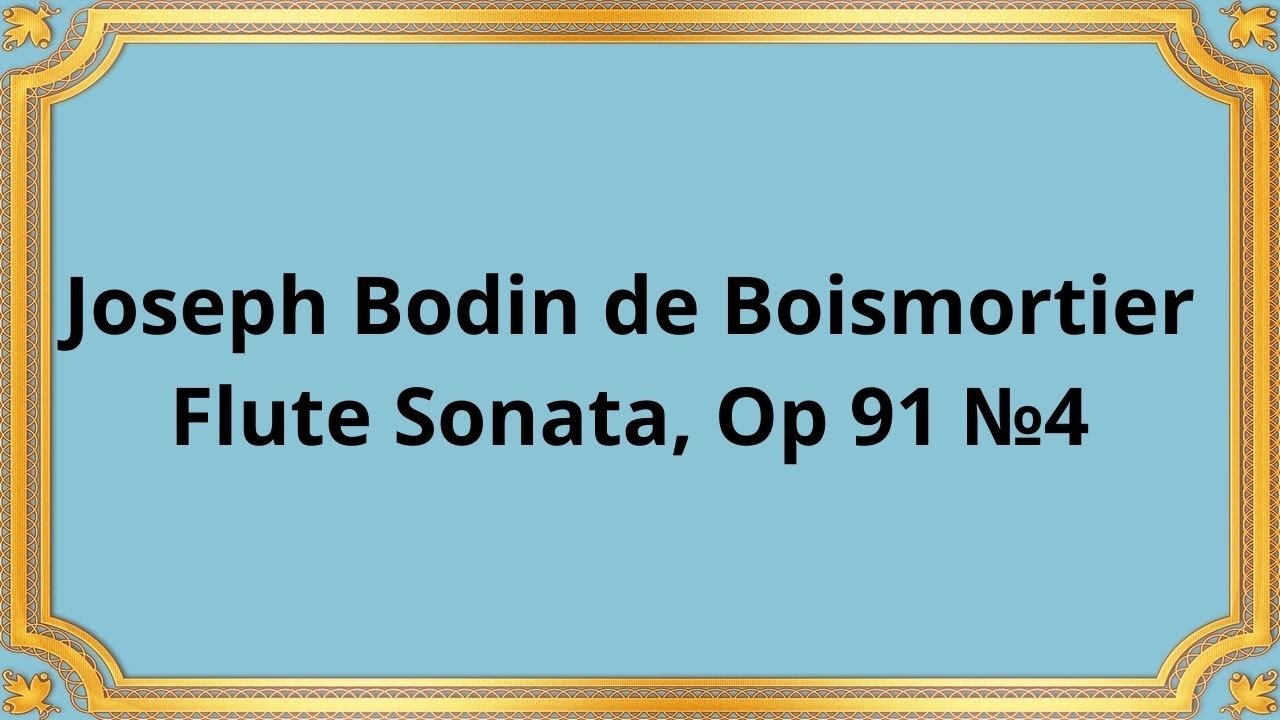Premium Only Content

Joseph Bodin de Boismortier Flute Sonata, Op 91 №4
#Boismortier #FluteSonata #ClassicalMusic #BaroqueComposer #MusicComposition #FluteMusic #ChamberMusic #BaroqueEra #FrenchComposer #Opus91
Rebecca Stuhr Rommereim, baroque flute
John Stuhr-Rommereim, harpsichord
The "Flute Sonata in G major, Op. 91 No. 4" by Joseph Bodin de Boismortier is a captivating musical work that exemplifies the elegance and charm of the Baroque era. Composed specifically for the flute, this sonata showcases Boismortier's exceptional ability to craft engaging and expressive music for the instrument.
Joseph Bodin de Boismortier, a renowned French composer of the Baroque period, made significant contributions to chamber music and composed several works for the flute. The Flute Sonata in G major, Op. 91 No. 4 stands as a shining example of his mastery in creating captivating compositions for the flute.
This sonata adheres to the traditional three-movement structure commonly found in Baroque sonatas. The opening movement, marked "Adagio," introduces a lyrical and expressive melody, allowing the flute to demonstrate its melodic capabilities. The second movement, often labeled "Allegro" or "Presto," is characterized by its lively and spirited nature, showcasing the technical prowess of the flutist. Finally, the sonata concludes with a dance-like movement, typically marked "Allegro" or "Presto," bringing the piece to a jubilant and exhilarating close.
Boismortier's Flute Sonata in G major, Op. 91 No. 4 encapsulates the essence of the Baroque era, featuring ornamented melodies, graceful phrasing, and intricate interplay between the flute and the accompanying basso continuo. The work embodies the spirit of the period, evoking elegance and refined musical expression.
The enduring appeal of this sonata lies in its melodic inventiveness, graceful ornamentation, and the interplay between the flute and the basso continuo, which creates a rich and harmonious tapestry of sound. Boismortier's skillful treatment of the flute as a soloist within the chamber music setting is evident throughout the sonata, showcasing the instrument's versatility and expressive capabilities.
In summary, Joseph Bodin de Boismortier's Flute Sonata in G major, Op. 91 No. 4 stands as a testament to the composer's mastery of the Baroque style and his deep understanding of the flute's expressive potential. Its enduring popularity among flutists, chamber music enthusiasts, and Baroque music aficionados attests to its significance as a cherished work within the genre.
You have the opportunity to support the channel:
https://destream.net/live/RadSiarAl/donate
https://www.buymeacoffee.com/6355radsiaral
-
 23:35
23:35
Classical music_Music Inspiration
1 month agoSergei Rachmaninoff Rhapsody on a Theme of Paganini, Op. 43
76 -
 LIVE
LIVE
Kim Iversen
17 hours agoKash & Bongino Say Epstein Killed Himself — Who Are They Covering For?
5,412 watching -
 LIVE
LIVE
Michael Franzese
56 minutes agoCNN’s Cartel Interview EXPOSED What’s Really Going On
919 watching -
 LIVE
LIVE
Dr. Drew
3 hours ago14 Years & 19 Meds: Why Laura Delano Stopped Years Of Psychiatric Drugs & Went "Unshrunk" + Paleovalley's Autumn Smith – Ask Dr. Drew
600 watching -
 LIVE
LIVE
Redacted News
1 hour agoIsrael launches Gaza total DESTRUCTION operation "Gideon's Chariots", JD Vance cancels trip
12,424 watching -
 LIVE
LIVE
vivafrei
3 hours agoFAFO! Congresswoman LaMonica McIver ARRESTED & CHARGED! Canadian Election Fraud! AND MORE!
13,247 watching -
 DVR
DVR
Stephen Gardner
59 minutes agoYou Won't BELIEVE What The Supreme Court Did To Trump!
2921 -
 LIVE
LIVE
LFA TV
20 hours agoLFA TV LIVE STREAM - TUESDAY 5/20/25
3,496 watching -
 1:13:34
1:13:34
Benny Johnson
2 hours ago🚨Trump Makes SHOCK Announcement LIVE Now From White House With Hegseth | Afghanistan Prosecutions!?
30.9K29 -
 36:03
36:03
The White House
2 hours agoPresident Trump Makes an Announcement with the Secretary of Defense
7.63K9